STOP: Largo Porta Nuova
Welcome to the Heart of Lower Town, the itinerary that will show you a thousand facets of the most modern part of Bergamo. Hours of leisure await you through post-Novecento neighborhoods, shopping streets and Renaissance villages suspended between Baroque and Neoclassicism.
You are at the Propilei di Porta Nuova (point 1), the neoclassical temples that have stood where the main medieval entrance to the city once opened since 1837. Within their setting you can enjoy an exceptional view of Upper Town, the perfect postcard of Bergamo.

PROPILEI DI PORTA NUOVA
o begin the itinerary, go straight along Viale Roma, keeping the sign on your right. After 50 meters you will reach Sentierone (point 2), Bergamo’s promenade par excellence: a magnificent tree-lined avenue among historic horse chestnut trees and impressive monuments. Turn right and in 150 meters, again on the right, you will see the Teatro Donizetti (point 3). Eighteenth-century in origin, it is dedicated to the Bergamo composer of the same name, one of the world’s five most celebrated opera composers. With a majestic structure and one of the largest halls in Italy, the theater carries on a great opera tradition year after year.

SENTIERONE

TEATRO DONIZETTI
Just 100 meters from the theater, at the end of the avenue awaits the Church of Sts. Bartolomeo and Stefano (point 4), built in the 1500s for the Dominican Order and designed by architect Antonio Maria Caneva. Preserved inside is the Martinengo Altarpiece, the largest painting ever made by the Venetian painter Lorenzo Lotto. Immediately to the right of the church begins Via Tasso, one of Bergamo’s historic streets. Take it and continue for another 250 meters; you will then reach the monumental Palazzo della Provincia (point 5), a fine example of late 19th-century architecture and home not only to the provincial offices but also to the Puppet Museum and the Sculpture Park, which houses works by the sculptor Manzù.
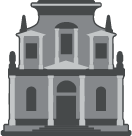
CHURCH OF STS. BARTOLOMEO E STEFANO

PALAZZO DELLA PROVINCIA
Continuing all the way to the end of Via Tasso, 450 meters from this sign you will find a second building of worship: the very special Church of Santo Spirito, which preserves another masterpiece by Lotto.
If you’re coming from Via Tasso because you’re going the opposite way, and you haven’t yet visited Borgo San Leonardo, to continue you’ll reach the Propilei di Porta Nuova, turn right and go all the way down Via Tiraboschi to Via Zambonate, where you’ll find the next sign.
STOP: Via Tasso
You are at the intersection of Via Tasso and Via Pignolo, which developed in the Middle Ages as extensions of the Upper Bergamo to become full-fledged neighborhoods. Via Tasso, in particular, was inhabited mostly by the city’s Waldensian community, which came from Switzerland to trade and then moved here permanently. It still houses the Protestant Cultural Center and its library.
Looking toward Via Pignolo, to the right of the sign stands the fascinating Church of Santo Spirito (point 6), recognizable by the large bronze sculpture emerging from the almost bare facade. Of 14th-century origins, this building has undergone numerous changes over the centuries; its interior contains a masterpiece by Lotto, the “Madonna and Child,” St. Catherine of Alexandria, St. Augustine, St. Sebastian and St. Anthony Abbot.
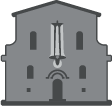
CHURCH OF SANTO SPIRITO
To continue, turn your back to the church and walk up Via Pignolo. After 200 meters spent among historic buildings and picturesque stores, you will find the neo-Gothic Church of St. Bernardino.
If, on the other hand, you are taking the route in the opposite direction and arriving from upper Via Pignolo, take Via Tasso keeping the Church of S. Spirito behind you and proceeding to the left. In 320 meters you’ll reach the Palazzo della Provincia (point 5), a majestic late-19th-century building where you’ll find the picturesque Puppet Museum and the Sculpture Park, which houses various works by Bergamo-born Giacomo Manzù.

PALAZZO DELLA PROVINCIA
After another 150 meters, you will find on the right the Church of Sts. Bartolomeo and Stefano, a magnificent place of worship overlooking the intersection of Via Tasso and Largo Belotti. It houses the Martinengo Altarpiece by Lorenzo Lotto and is definitely worth a visit. Finally, having reached the beautiful Sentierone avenue, on the left you can also admire the Teatro Donizetti.
STOP: Via Pignolo bassa
You are standing at the intersection of Via Verdi and Via Pignolo, the soul of one of the boroughs that developed as offshoots of the Upper Town starting in the Middle Age. On the corner behind you, on the other side of the street, is the Church of S. Bernardino (point 7). Reach the doorway of this late medieval church and be amazed by the rich simplicity of its single nave, decorated with a masterpiece by Lorenzo Lotto.

CHURCH S. BERNARDINO
To continue, keep the church entrance on your right and continue on Via Pignolo. After 170 meters, you will meet on the left Palazzo Agliardi (point 8), an aristocratic mansion built in the 1500s and still inhabited by the Counts of the same name; it has interiors decorated with fine frescoes by Carloni and Ferrario, as well as a hanging garden.

PALAZZO AGLIARDI
Almost opposite stands the Church of St. Alessandro della Croce (point 9), whose origins date back as far as the 4th century AD. Inside you can admire two works by Moroni and an altar in polychrome marble by Andrea Fantoni. If you’d like to take a little detour, about 50 meters further on here is one of the city’s most picturesque little squares: at its center, the Fontana del Delfino (Dolphin Fountain) (point 10) adorned with aquatic figures in white marble.
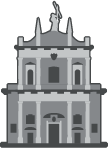
CHURCH OF ST. ALESSANDRO DELLA CROCE

FONTANA DEL DELFINO (DOLPHIN FOUNTAIN)
If, on the other hand, you are coming from Upper Pignolo Street and have already visited these places, to continue go left and go down to Piazzetta S. Spirito. After 180 meters you will find the Church of Santo Spirito (point 6), founded in the 14th century and come down to us after several stylistic transformations; it houses, among other works, a painting by Lorenzo Lotto.

CHURCH OF SANTO SPIRITO
STOP: Via Pignolo alta
You’re at the intersection of Via Pignolo alta and Via Masone, in the heart of that historic village that, for centuries, has connected the two halves of Bergamo by winding between aristocratic palaces and commercial stores.
To the right of the sign you’ll find the monumental Church of S. Alessandro della Croce (point 9). Present perhaps as early as the 4th century A.D., at the time of the saint’s martyrdom, It is said that the name “della Croce” comes from its being at the intersection of four medieval villages. The present building of the 16th-17th century features two paintings by Moroni and a polychrome altar by Andrea Fantoni. With a short detour of 50 meters, proceeding up Via Pignolo, you can also admire one of Bergamo’s most picturesque squares. Dominating the center is the Fontana del Delfino (Dolphin Fountain) (point 10), adorned with white marble aquatic figures and a pine cone, the ancient symbol of the neighborhood.

CHURCH OF S. ALESSANDRO DELLA CROCE

FONTANA DEL DELFINO (DOLPHIN FOUNTAIN)
Then return to the main path as you reach the sign and turn right. Here a descent begins that will make you cross through the centuries, passing from the Renaissance and Baroque city to the modern one in just 470 meters, among villas, the Istituto delle Suore Orsoline (Ursuline Sisters Institute) and the former church of Santa Maria Elisabetta. At the far end awaits the Palazzo delle Poste (point 11), inaugurated in 1932 and an example of avant-garde architecture that will amaze you with its blown-glass lamps, marble floors and refined furnishings.
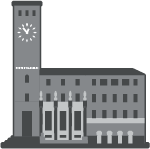
PALAZZO DELLE POSTE
If, on the other hand, you arrive from Via Masone, to continue on the itinerary turn left of the sign and walk down Via Pignolo. In 30 meters, at number 86 you will find the beautiful Palazzo Agliardi (point 8), a 16th-century aristocratic residence decorated with fine frescoes by Carloni and Ferrario. Since 1845 it has been inhabited by the Counts of the same name, who welcome visitors for tours and other events.

PALAZZO AGLIARDI
150 meters further on, at the corner with Via San Giovanni on the left, you will encounter the Church of S. Bernardino (point 7), an ancient jewel with a neo-Gothic facade, on whose altar stands a splendid altarpiece by Lotto.

CHIESA S. BERNARDINO
STOP: Via Masone
You are standing at the intersection of Via Locatelli and Via Masone, in one of the city’s most eclectic neighborhoods. Almost in front of you, slightly to the right, stands the majestic tower of the Palazzo delle Poste (point 11), one of the architectural works created during the avant-garde period. This Mazzoni-designed building has housed post offices since it was built in 1932; have fun discovering its decorations inside and out, including marble floors, blown-glass lamps, and refined furnishings.

PALAZZO DELLE POSTE
To continue, leave the sign behind and continue on Via Locatelli. After 190 meters, turning onto the first street on the right, you can make a brief détour to Piazza della Libertà (point 12), also built during the major renovations of the Trentennio. In its center stands a monumental fountain and, as a scenic backdrop, stands the Casa della Libertà – formerly Casa Littoria – built in 1937.

PIAZZA DELLA LIBERTÀ
To reach the next stop, backtrack your steps on Via Locatelli; after about 200 meters turn onto Via Monte Sabotino. You will find yourself in the green Piazza Dante (point 13), located next to the Sentierone four-sided portico, framed by monumental buildings such as the Palazzo della Procura and the Chamber of Commerce.

PIAZZA DANTE
The next stop, Piazza Vittorio Veneto, awaits you behind the Credito Italiano building. You can pass under the arcades just to its left.
If you come from that direction and travel the itinerary in the opposite direction, to continue turn right at the sign, go up Via Masone and reach Via Pignolo. The climb will take you through the centuries, passing from the Renaissance and Baroque city to the modern one, among villas and buildings such as the Istituto delle Suore Orsoline and the former church of Santa Maria Elisabetta.
STOP: Largo Belotti
You are now at the intersection of Largo Belotti and Via Monte Sabotino, just a few steps away from one of the city’s most iconic squares: Piazza Dante (point 13). To reach it, turn right and walk 70 meters. At the center of its balanced geometries and plays of perspective stands a fountain depicting Neptune surrounded by tritons and sea horses. Below the pavement awaits you the ex-Diurno, an air-raid shelter that has become a gathering place since the postwar period thanks to various businesses.

PIAZZA DANTE
After exploring the square, take the passage under the arcades just to the left of the Credito Italiano. You will then reach Piazza Vittorio Veneto and the next monument, the Torre dei Caduti (point 14). Inside you can discover the history of the Piacentiniano Center and, from the top, enjoy a splendid view of Bergamo.

TORRE DEI CADUTI
If you take the itinerary in the opposite direction, however, go up Largo Belotti in the direction of the Upper Town. Reaching the intersection with Via Petrarca, turn left and you can visit Piazza della Libertà (point 12), 160 meters away from the sign. Made during the major renovations of the early 20th century, it too is dominated by a fountain and monumental buildings such as the Casa della Libertà, built after the demolition of the old Ospedale San Marco in 1937.

PIAZZA DELLA LIBERTÀ
After this short detour, return to Via Locatelli and continue for about 120 meters. In front of you, slightly to the right, you will see the tall tower of the Palazzo delle Poste (point 11).

PALAZZO DELLE POSTE
STOP: Viale Roma
You are on Viale Roma, on the main artery of the Lower town , at the scenic Piazza Vittorio Veneto. Behind you is the Torre dei Caduti (Point 14), towering over the city from its 45-meter height. Inside, a museum exhibit will take you up to the sixth floor telling the story of the Piacentiniano Center, built in the first thirty years of the 20th century; from the top you will then enjoy a breathtaking view.

TORRE DEI CADUTI
Continuing under the portico and taking the Galleria Santa Marta, 60 meters away you’ll discover a little hidden gem, the Cloister of Santa Marta (point 15), all that remains of a 14th-century cloister; it houses the Cardinale Seduto (Seated Cardinal) by the celebrated Bergamo sculptor Giacomo Manzù.

CLOISTER OF SANTA MARTA
Back in the main gallery corridor, continue to the right to Piazza Giacomo Matteotti. After about 100 meters you’ll come across Palazzo Frizzoni, once owned by the Swiss Protestant family of the same name, now the seat of Bergamo City Hall.
If you take the itinerary in the opposite direction instead, looking at the sign, go straight ahead. Beyond the arcades you’ll find Piazza Dante (point 13), part of the Centro Piacentiniano that revolutionized the heart of the Lower Town in the 1920s. In the center, among imposing buildings such as the Palazzo della Procura and the Chamber of Commerce, stands a fountain in Zandobbio marble. Beneath the pavement opens the ex-Diurno, an air-raid shelter converted into a meeting place after the end of the last conflict.

PIAZZA DANTE
In this area the looped route comes very close to overlapping: if you go straight and turn right, you will come out on Sentierone right in front of the Teatro Donizetti (point 3), near the Church of SS. Bartolomeo and Stefano (point 4). But if you want to follow the path accurately, go straight and curving slightly to the left take Via Monte Sabotino to reach Largo Bortolo Belotti.

TEATRO DONIZETTI

CHURCH OF SS. BARTOLOMEO E STEFANO
STOP: Piazza Matteotti
You are in Piazza Matteotti, one of the city’s central spaces, not far from Via XX Settembre and the shopping triangle. With your back to the sign, on your right you’ll see Palazzo Frizzoni (point 16), a luminous example of mid-19th-century Neoclassicism; it owes its name to one of Bergamo’s leading Waldensian families, who made it their residence. Within its walls are treasured spaces such as the Galleria dei Cardinali and the Sala degli Specchi.

PALAZZO FRIZZONI
The street merges after 300 meters into Via S. Alessandro, another historic downtown suburb. If you take the short detour to the right you’ll be able to see both the Renaissance convent of S. Benedetto, and the former Church of S. Maria Maddalena. On your left, however, you will have the Church of Sant’Alessandro in Colonna.
If you take the itinerary in the opposite direction, turn left, pass Palazzo Frizzoni and enter Galleria Santa Marta. After 150 meters, the somewhat dimly shaded portico will open up on the left, giving you a chance to reach the gate of a hidden gem: the Cloister of Santa Marta (point 15). The only surviving part of an ancient 14th-century cloister, it is an oasis of tranquility that holds sculptural masterpieces such as Giacomo Manzù’s Cardinale Seduto (Seated Cardinal).

CHIOSTRO DI SANTA MARTA
Continuing on the gallery, after 120 meters you will reach the arcades of Piazza Vittorio Veneto and the Torre dei Caduti (point 14), with its six floors of exhibition space dedicated to the Piacentiniano Center and an unmissable panoramic view of the city. Leaving the tower, you will then have to turn left and cross the street.

TORRE DEI CADUTI
STOP: Via S. Alessandro
You’re on Via S. Alessandro, the hub of the ancient village of Santo Stefano. Behind the sign you can admire the column that stands where, according to legend, the saint was martyred, the only evidence of the cathedral dedicated to him in the fourth century.On the left stands the Church of Sant’Alessandro in Colonna (point 17), founded in 1447. Inside you’ll find valuable works such as Lorenzo Lotto’s Compianto sul Cristo morto (Lamentation over the Dead Christ), a rare example of tempera on canvas.
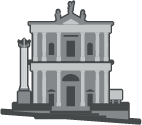
CHURCH OF SANT’ALESSANDRO IN COLONNA
After visiting it, you can take a short detour from the main itinerary by going up Via S. Alessandro for a stretch: 30 meters from the sign, on the right, you will find the entrance to the former church of S. Maria Maddalena (point 18). Once a place of worship with an adjoining hospital for the poor, it is now a space dedicated to exhibitions, conventions and performances.

CHURCH OF S.MARIA MADDALENA
Continuing straight for another 200 meters, past Via Garibaldi, you will reach the magnificent San Benedetto Monastery (point 19). Dating back to the 15th century, this fascinating complex was built for a Benedictine community and is an authentic jewel of Lombard Renaissance architecture. From here return to the main path back down the road, pass the Church of Sant’Alessandro in Colonna and continue to Largo Rezzara. Going straight ahead you will reach Piazza Pontida (point 20), in the heart of Borgo San Leonardo.

SAN BENEDETTO MONASTERY

PIAZZA PONTIDA
If you follow the itinerary in the opposite direction and arrive from Piazza Pontida, to continue turn left of the sign and take Via Borfuro. Despite its predominantly modern appearance, the street has ancient origins and a history partially linked to Bergamo’s Waldensian community, which gathered here to worship privately. After about 300 meters, you will reach Piazza Matteotti at the intersection with Via XX Settembre, one of the main shopping streets.
STOP: Largo Rezzara
You are at the intersection of Largo Rezzara and Via Sant’Alessandro, in the heart of Borgo San Leonardo, the “star-shaped” neighborhood that has animated Bergamo with its liveliness for centuries, thanks to its artisan and commercial vocation. Just a few meters from the sign, leaving Via Sant’Alessandro behind and going straight ahead, you will find Piazza Pontida (point 20). In the past it was one of the most important commercial spaces in the city thanks to the lumber business, a vocation to which was later added the social one of gathering.

PIAZZA PONTIDA
After exploring to your own liking leave Largo Cinque Vie and take Via Zambonate to the first intersection. Here turn right onto Via Quarenghi and then onto Via Spaventa to discover more local stores and businesses. You will soon reach Via Tiraboschi and Porta Nuova, from which to embark on new adventures!
If you follow the itinerary in the opposite direction and arrive right from Porta Nuova, to continue take Via Sant’Alessandro keeping Largo Rezzara behind you. After 160 meters and after discovering numerous palaces and stores, you will reach the beautiful Church of S. Alessandro in Colonna (point 17), followed by the former Church of S. Maria Maddalena (point 18).

CHURCH OF S. ALESSANDRO IN COLONNA

CHURCH OF S. MARIA MADDALENA
STOP: Via Zambonate
You are in Borgo San Leonardo (point 21), one of Lower Town’s historic neighborhoods and crossroads, developed at the confluence of five streets. To reach Piazza Pontida (point 20), its hub, turn your back on the sign, go straight ahead and in 100 meters turn right onto Largo Cinque Vie. In about 200 meters you’ll find yourself among arcades and colorful buildings that, in the past, presided over important trade in lumber from the valleys and that, today, surround a beloved meeting place. Don’t miss the chance to enjoy an aperitif!
It is also home to the ‘Ducato di Piazza Pontida’ (Duchy of Pontida Square), a goliardic association that has kept Bergamo’s culture, art and folklore alive since the early 1900s.

BORGO SAN LEONARDO

PIAZZA PONTIDA
The itinerary then takes you to Via Sant’Alessandro, straight ahead for about 270 meters, where you will find the ancient Church of S. Alessandro in Colonna (point 17).

CHURCH OF S.ALESSANDRO IN COLONNA
If you take the route in the opposite direction, you have almost finished your walk! To return to the starting point, the Propilei di Porta Nuova (New Gate Propylaeums, point 1) and thus close the loop of the itinerary, cross the street to the right of the sign. Along the upper Via Quarenghi and Via Spaventa there are numerous stores and interesting sights for you to discover.

PROPILEI DI PORTA NUOVA
STOP: Via Quarenghi
You’re at the intersection of Via Quarenghi and Via Spaventa, in Borgo San Leonardo (San Leonardo borough, point 21), which has perfectly embodied the commercial and creative soul of Bergamo for centuries. Located roughly in the area between Via Zambonate and Via Palma il Vecchio, it will amaze you with its stores, bistros and restaurants, not to mention the many events that animate it every year.

BORGO SAN LEONARDO
If you follow the route in the recommended direction and arrive from Piazza Pontida, to continue turn left and take Via Spaventa. At the intersection with the traffic light, cross the street to the right to reach via Tiraboschi and continue straight ahead. In about 500 meters you will be back at the starting point, the Propilei di Porta nuova (New Gate Propylaeums, point 1), Bergamo’s main crossroads built at an ancient entrance in the medieval walls. At this point you will have completed the Heart of Lower Town itinerary.

PROPILEI DI PORTA NUOVA
On the other hand, if you take the itinerary in the opposite direction and arrive from Porta Nuova, to continue turn right and enter Borgo San Leonardo. You will soon reach Largo 5 vie and Piazza Pontida (point 20), 350 meters from the sign. With its history, architecture, and numerous venues, this gathering place will not fail to amaze you…and keep you there for an aperitif and some shopping!

PIAZZA PONTIDA
STOP: Via Paglia
You are standing at the intersection of Via Tiraboschi, Via Paglia, Via Spaventa, and Via Zambonate, a bustling neuralgic point that seems to mirror the other famous intersection of Borgo San Leonardo (San Leonardo borough, point 21), Largo Cinque Vie. The district has ancient origins and is a very large commercial area, reaching all the way to Via Palma il Vecchio: the itinerary takes you through part of it, to give you plenty of ideas for future walks!

BORGO SAN LEONARDO
If you have already visited it and want to end the itinerary, turn right and walk down Via Tiraboschi. Even if it is a modern street, it doesn’t lack in buildings of interest, such as the building at number 27 – an important example of a 19th-century neoclassical facade – and the Palazzo degli Uffici Comunali on the other side of the street. After about 300 meters you will have reached the Propilei di Porta Nuova (New Gate Propylaeums, point 1) and completed the Heart of Lower Town. Congratulations!

PROPILEI DI PORTA NUOVA
If you instead take the route in the opposite direction, to discover Borgo San Leonardo cross the streets behind the sign, then turn left onto Via Spaventa.
After about 230 meters among modern buildings and stores, you’ll reach via Quarenghi alta and enter the most historic part of the neighborhood.

